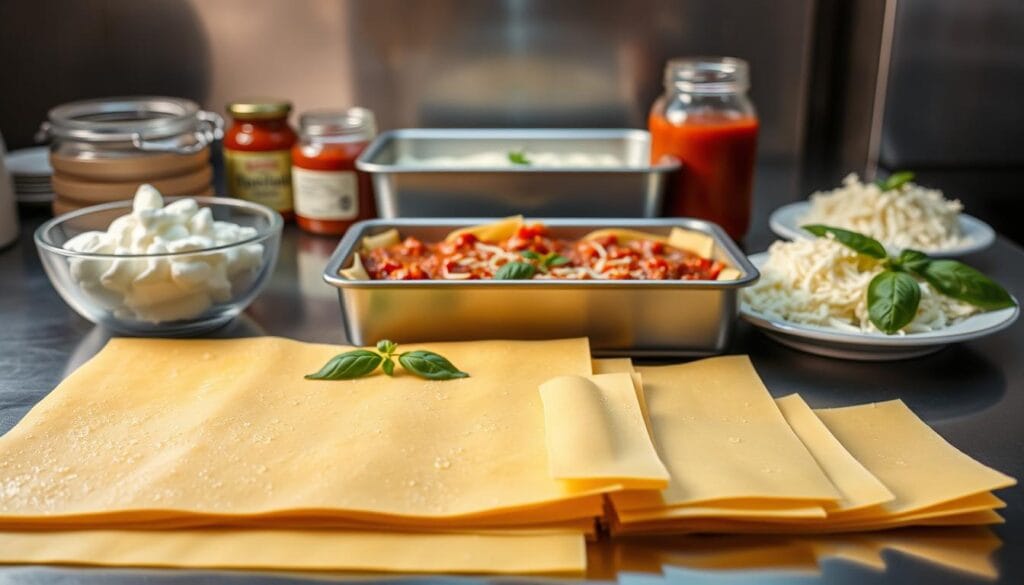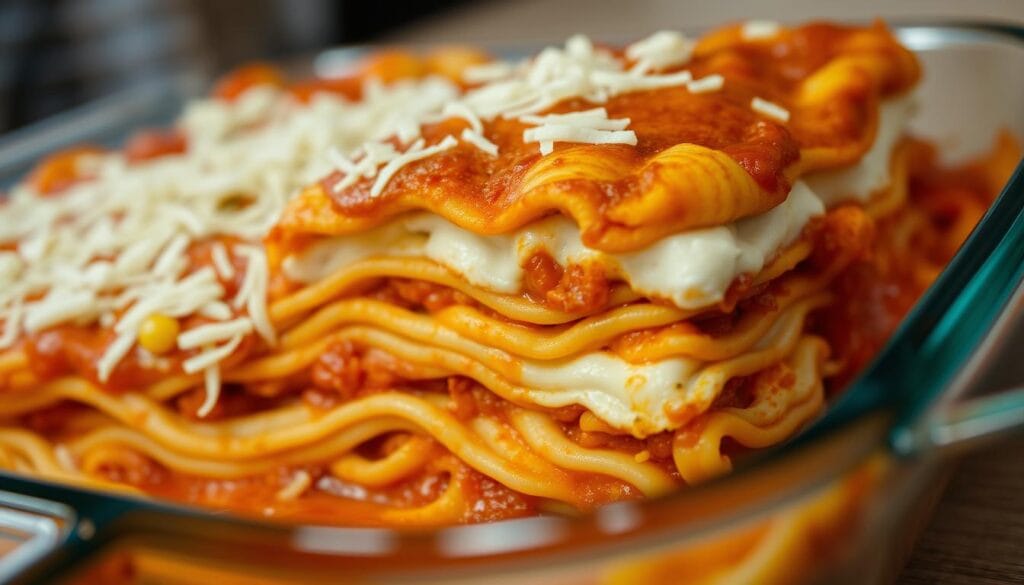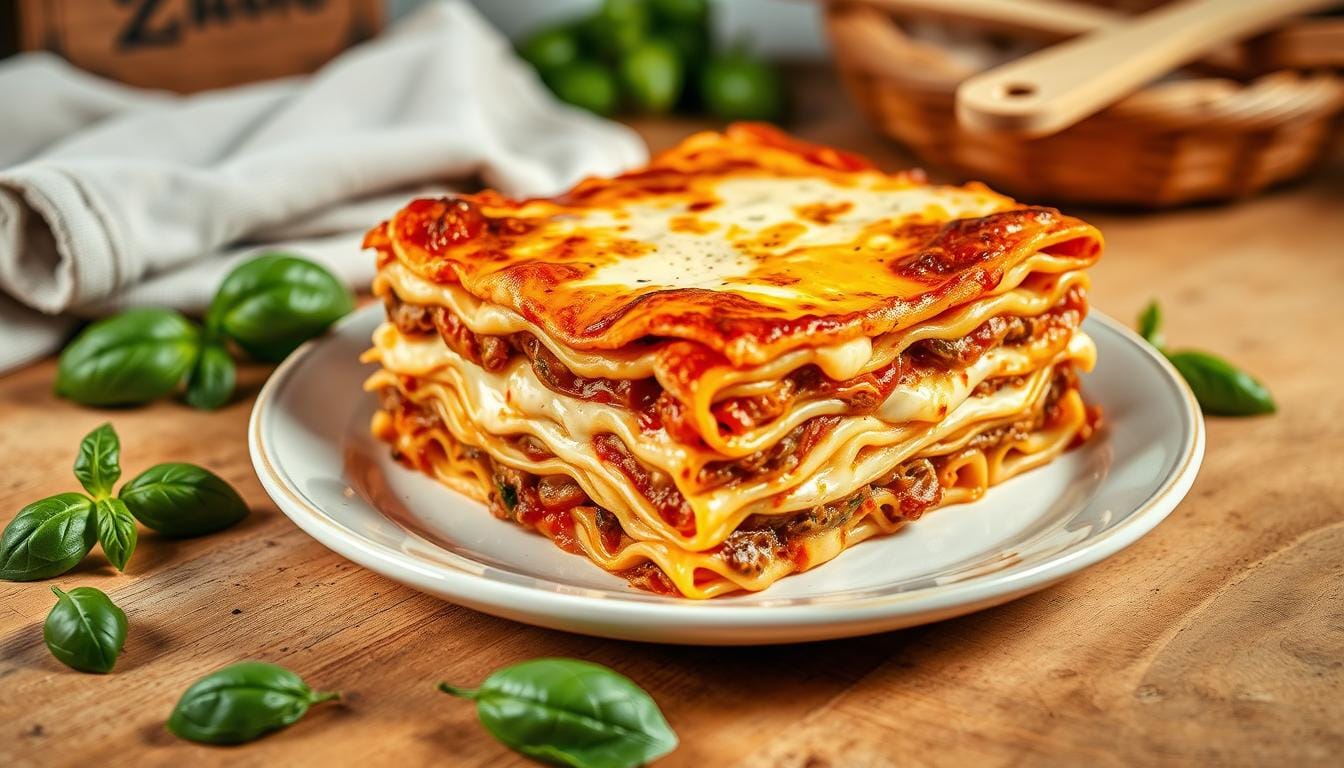Imagine the smell of savory meat sauce and baked cheese filling your kitchen. As you invite friends and family to dinner, your homemade lasagna comes out of the oven. It’s not just a meal; it’s a way to connect and celebrate flavors together.
In this guide, you’ll learn how to make a classic lasagna recipe that’s both tasty and easy. Whether you’re a beginner or an experienced cook, you’ll find the secrets to making this lasagna a favorite in your kitchen.
Table of Contents
Key Takeaways
- Experience the joy of pulling together a classic lasagna recipe from scratch.
- Learn about essential ingredients that elevate your homemade lasagna.
- Explore various meat options and cheese varieties to customize your dish.
- Discover practical tips for assembling and baking perfect layers.
- Get insights into storing and reheating leftovers for future enjoyment.
Introduction to Homemade Lasagna
Homemade lasagna is a delicious treat that brings comfort to many homes. It’s a classic Italian dish with layers of pasta, meat, cheese, and sauce. It’s great for big gatherings or small family dinners.
With an easy lasagna recipe, anyone can make it, even if you’re new to cooking. You can also change the ingredients to fit your taste. This makes each bite a special experience for everyone.
As you follow this guide, you’ll learn how to make this tasty dish. You’ll see that making your own lasagna is easy and very rewarding.
Essential Lasagna Ingredients
The key to a great meat lasagna is the ingredients you choose. The right mix can make the flavors pop and the texture better. Think about each part, from the meat to the cheese and sauce.
Meat Options for Your Lasagna
Ground beef and pork are top picks for meat lasagna. They give a rich, savory taste. Ground turkey is a lighter choice. For a meatless option, mushrooms or lentils are great, keeping the flavors strong.
Cheese Varieties to Consider
Cheese is essential for lasagna’s creaminess. Mixing cottage cheese and ricotta makes a creamy layer. Mozzarella adds a gooey touch. Sprinkle Parmesan for a sharp flavor.
Choosing the Right Tomatoes
The sauce is the heart of lasagna. Use fresh tomatoes in season or high-quality canned ones like San Marzano. They balance acidity well. A bit of sugar can balance the acidity, making the flavors work together.
Preparing the Meat Sauce
Making a tasty meat sauce is key for a great lasagna. It adds depth and flavor to each layer. The right mix of ingredients will make your lasagna stand out.
Cooking Ground Meat to Perfection
Start by browning ground meat in a skillet over medium heat. Use a wooden spoon to break it up, so it cooks evenly. When it starts to crumble, add diced onions for sweetness.
This combo gives your meat sauce a strong flavor and texture.
Incorporating Fresh Herbs and Spices
To make your meat sauce pop, add fresh Italian herbs like basil and parsley. They blend well with other ingredients, creating a balanced taste. Feel free to try different spices to make it your own.
Balancing Acidity with Sugar
Tomatoes can make flavors seem off-balance. To fix this, add a bit of sugar to your sauce. It balances the acidity, making the flavor just right. For more depth, try adding a splash of cooking wine.
Choosing the Right Lasagna Noodles

When making homemade lasagna, picking the right noodles is key. You have two main choices: traditional cooked noodles and no-boil noodles. Each affects the lasagna’s texture, so it’s important to know the difference.
Types of Lasagna Noodles: Cooked vs. No-Boil
Traditional noodles need boiling before you layer them. This lets you control their firmness. No-boil noodles, on the other hand, soften in the oven. They save time but ensure a hearty dish if layered right.
Both types can make delicious lasagna. But, your choice can change how you make it.
Cooking Lasagna Noodles for Optimal Texture
For cooked noodles, timing is everything. Boil them a bit less than the package says to avoid sogginess. Overcooking makes them mushy, ruining the layers.
No-boil noodles need careful following of package instructions. This ensures they soak up enough moisture to be tender but keep their shape.
Creating the Cheese Layer
The cheese layer in lasagna is key to its richness and texture. Mixing different cheeses creates a creamy feel. Cottage cheese and ricotta together add moisture, making each bite a joy.
Merging Cottage Cheese and Ricotta
Cottage cheese and ricotta cheese make a rich and tasty base. They add depth and texture to the cheese layer. Mixing smooth ricotta with chunky cottage cheese gives your lasagna a perfect bite.
The Role of Eggs in the Cheese Mixture
Eggs are vital in the cheese mixture for lasagna. They help the cheese stay together when baked. This keeps the cheese layer firm, ensuring each slice is perfect.
Assembling the Layers of Lasagna

Mastering lasagna assembly is key to a dish that looks great and tastes amazing. Start with a layer of meat sauce, then noodles, and finish with cheese. This method makes each layer distinct, adding to the dish’s texture and flavor.
Layering Techniques for Best Results
For the best results, follow these layering tips:
- Begin with a thin layer of meat sauce at the bottom to prevent sticking.
- Put your first layer of noodles, making sure they overlap a bit.
- Spread a layer of cheese mixture on top, covering the edges.
- Keep alternating layers until you’ve used all your ingredients, ending with sauce on top.
Tips for Even Distribution of Ingredients
Evenly distributing ingredients is important for the taste and structure of your lasagna. Here are some tips:
- Measure your ingredients to make sure you have enough for each layer.
- Use a spatula to spread layers evenly, avoiding clumps.
- Place toothpicks in the cheese layer before covering with foil. This keeps the cheese from sticking during baking.
Baking Your Homemade Lasagna
Baking lasagna right is key to great taste and texture. The oven temperature is a big part of this. Preheating is a must for a successful dish. This guide will help you bake your lasagna perfectly, focusing on the right oven temperature and how to get that golden top.
Setting the Right Oven Temperature
The best oven temperature for lasagna is 375°F. This temperature ensures even heating and melted cheese. Preheat your oven before baking to cook the lasagna evenly from the start.
Covering and Uncovering for Perfect Texture
Start by covering the lasagna with aluminum foil. This keeps moisture in and helps flavors blend. After 40 minutes, remove the foil to let the cheese brown and create a crust. The whole baking time is about 50 minutes, followed by a 10 to 15 minute rest. This rest helps the layers set and makes slicing easier.
Storing and Reheating Lasagna
Storing and reheating lasagna right can make your meals better and cut down on waste. When you have leftover lasagna, it’s key to store it well to keep its taste and texture. Knowing how to refrigerate and freeze lasagna helps it stay delicious for later.
How to Refrigerate Leftover Lasagna
To keep your leftover lasagna fresh, put it in an airtight container. This keeps moisture and flavors in, keeping it tasting like new. Make sure to eat it within four days for the best taste. Keep your fridge at or below 40°F to keep food safe.
Enjoying leftover lasagna soon after cooking is easy and satisfying.
Freezing Lasagna for Future Meals
Freezing is a good choice if you want to save lasagna for later. Wrap it tightly in aluminum foil and plastic wrap to avoid freezer burn. If it’s not baked yet, it can stay in the freezer for up to three months.
For the best results, label the package with the date. This way, you’ll know when to use it. To thaw frozen lasagna, let it sit in the fridge overnight. Then, bake it until it’s hot and bubbly.
Serving Suggestions for Your Lasagna
When serving lasagna, aim to enhance its rich flavors and hearty texture. There are many side dishes that can make your meal better. Light salads, garlic bread, or roasted vegetables are great choices to pair with lasagna.
Pairing with Side Dishes
Choosing the right side dishes can make your lasagna meal even better. Here are some excellent options:
- Garlic Bread – A classic choice that pairs beautifully with the Italian flavors of lasagna.
- Caesar Salad – Fresh romaine, croutons, and Parmesan deliver a crisp counterbalance to the dish.
- Steamed Vegetables – Broccoli, carrots, or green beans add color and nutrients to your plate.
- Caprese Salad – Combine fresh mozzarella, tomatoes, and basil for a refreshing touch.
Creative Ways to Serve Leftovers
Lasagna leftovers can be just as delightful as the first serving. Here are some creative ways to enjoy them:
- Lasagna Wraps – Create wraps using tortillas, adding fresh spinach or arugula for added freshness.
- Lasagna Cups – Use muffin tins to bake individual servings for easy reheating and serving.
- Layered Salads – Incorporate chopped lasagna into a salad for a hearty, protein-rich meal.
- Stuffed Peppers – Hollow out bell peppers and fill them with lasagna for a unique dish.
With these serving suggestions, you can create a satisfying dining experience. You’ll also make the most of your leftovers.
Variations of Classic Lasagna

Lasagna is a blank canvas for your creativity. You can try many different lasagna forms. Each one has its own ingredients and ways of making it. You can go from traditional meat lasagna to innovative vegetarian options.
Vegetarian Lasagna Options
Try a vegetarian lasagna for a tasty twist. Use fresh veggies like spinach, mushrooms, or bell peppers. Mix them with ricotta and mozzarella for creaminess. Adding pesto or marinara sauce makes it flavorful and light.
With so many veggie combinations, each vegetarian lasagna is unique. It can taste different every time you make it.
Meat Lasagna: Composite Recipes
Want to make your meat lasagna stand out? Mix different meats like beef, pork, or sausage. This adds depth to the flavor. Use various cheeses for richness.
Don’t be afraid to add spices and herbs to the sauce. This will make your meat lasagna truly special.
Lasagna Roll Ups and Zucchini Lasagna
Lasagna roll ups are fun and easy to eat. Fill cooked lasagna noodles with cheese and meat or veggies. They make great individual servings.
For a gluten-free option, use zucchini instead of noodles. Zucchini lasagna is fresh and keeps the lasagna spirit alive.
Common Mistakes to Avoid During Preparation
Making the perfect lasagna needs careful attention. Avoiding common mistakes can greatly improve your dish. Focus on noodles and the cheese layer for better results. Knowing these pitfalls will make your lasagna more enjoyable.
Overcooking Noodles and Ingredients
One big mistake is overcooking noodles and ingredients. Noodles cook more in the oven, making them mushy if over-boiled. Use al dente pasta for better texture and layering. Cool noodles quickly to keep their shape.
Getting the Cheese Layer Just Right
The cheese layer can be tricky. Issues come from wrong ratios or too much water. Mix cottage cheese and ricotta well, adding egg for binding. This helps avoid too much moisture and boosts flavor.
Conclusion
Creating perfect homemade lasagna is easy. This classic recipe is a delightful journey that fills your kitchen with amazing smells. It’s a sign of cozy meals to come.
With this guide, you can make a lasagna that shows off your taste. From picking the best ingredients to baking it just right, every step makes it better. You’ll serve a dish that everyone will love.
Homemade lasagna is special because it’s so flexible and brings people together. Now, you can impress with classic or new recipes. Enjoy your cooking journey and the pride of a job well done!

